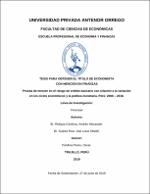Prueba de tensión en el riesgo de crédito bancario con relación a la variación en los ciclos económicos y la política monetaria. Perú: 2008 - 2018

View/
Download
(application/pdf: 56.62Kb)
(application/pdf: 56.62Kb)
Date
2019Author(s)
Rebaza Córdova, Andrés Alexander
Suárez Ruiz, Joel Louis Stiwell.
Metadata
Show full item recordAbstract
La presente investigación pretende determinar el impacto de una prueba de tensión en
el riesgo de crédito del sector bancario peruano, mediante un modelo econométrico de
tipo panel balanceado para el periodo 2008.01 – 2018.04 (308 observaciones). La
metodología utilizada fue de tipo descriptiva y de análisis documental. Los datos
estadísticos para la investigación fueron extraídos de la Superintendencia de Banca y
Seguros y AFP´S y del Banco Central de Reserva del Perú; el procesamiento de los
datos se realizó mediante estimaciones econométricas en el software E-views 6.0, con
la finalidad de describir el impacto entre las variables del modelo; teniendo como
variable dependiente al riesgo de crédito del sector bancario peruano (RRC) y como
variables independientes a los ciclos económicos (VPBIR) y tasa de referencia de la
política monetaria (TRPM). Los resultados estimados aceptaron la hipótesis y
confirmaron que existe una relación negativa entre las variables del modelo, en
concordad con los resultados obtenidos por Alfaro, Calvo y Oda (2008) y Salcedo
(2012). El impacto de la prueba de tensión efectuada para el riesgo de crédito se
cuantificó en un 2.03 y un 10.61 por cada variable independiente, respectivamente; es
decir por cada reducción en un punto porcentual en los ciclos económicos, el riesgo
de crédito se incrementa en 2.03 puntos porcentuales; asimismo, por cada reducción
de un punto porcentual en la tasa de referencia de la política monetaria, el riesgo de
crédito aumenta en 10.61 puntos porcentuales. Se recomienda que, en los futuros
estudios, relacionados a pruebas de tensión se incluyan variables económicas que
permitan estimar o medir el “efecto contagio” generado por crisis externas y su impacto
en el sistema bancario peruano. This research aims to determine the impact of a stress test on the credit risk of the
Peruvian banking sector, using an econometric model of type panel for the period
2008.01 - 2018.04 (308 comments). The methodology used was descriptive and
documentary analysis. The statistical data for the research were extracted from the
Superintendency of banking and insurance and AFP´S and the Banco Central of
reservation of the Peru; These data processing was performed using econometric
estimates software 6.0 E-views, in order to describe the impact among the variables of
the model; having as dependent variable to the credit risk of the Peruvian banking
sector (RRC) and independent variables (VPBIR) economic cycles and monetary policy
(TRPM) benchmark rate. The results agreed the hypothesis and confirmed that there
is a negative relationship between the variables of the model, in concordad with the
results obtained by Calvo, Alfaro, Salcedo (2012) and Oda (2008). The impact of test
voltage for credit risk is quantified in a 2.03 and a 10.61 for each independent variable,
respectively; i.e. each reduction by one percentage point in economic cycles, the credit
risk is increased by 2.03 percentage points; In addition, for each reduction of one
percentage point in the rate of monetary policy, credit risk increases in 10.61
percentage points. It is recommended that in future studies, related to stress tests
include economic variables that allow to estimate or measure the ““contagion effect““
generated by external shocks and their impact on the Peruvian banking system.
Collections
- Economía y Finanzas [87]

